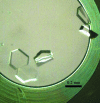Structure of SurE protein from Aquifex aeolicus VF5 at 1.5 A resolution
- PMID: 20054112
- PMCID: PMC2802864
- DOI: 10.1107/S1744309109043814
Structure of SurE protein from Aquifex aeolicus VF5 at 1.5 A resolution
Abstract
SurE is a stationary-phase survival protein found in bacteria, eukaryotes and archaea that exhibits a divalent-metal-ion-dependent phosphatase activity and acts as a nucleotidase and polyphosphate phosphohydrolase. The structure of the SurE protein from the hyperthermophile Aquifex aeolicus has been solved at 1.5 A resolution using molecular replacement with one dimer in the asymmetric unit and refined to an R factor of 15.6%. The crystal packing reveals that two dimers assemble to form a tetramer, although gel-filtration chromatography showed the presence of only a dimer in solution. The phosphatase active-site pocket was occupied by sulfate ions from the crystallization medium.
Figures



Similar articles
-
Structure of D-lactate dehydrogenase from Aquifex aeolicus complexed with NAD(+) and lactic acid (or pyruvate).Acta Crystallogr Sect F Struct Biol Cryst Commun. 2009 Dec 1;65(Pt 12):1209-13. doi: 10.1107/S1744309109044935. Epub 2009 Nov 27. Acta Crystallogr Sect F Struct Biol Cryst Commun. 2009. PMID: 20054113 Free PMC article.
-
Structural and functional studies on a mesophilic stationary phase survival protein (Sur E) from Salmonella typhimurium.FEBS J. 2008 Dec;275(23):5855-64. doi: 10.1111/j.1742-4658.2008.06715.x. FEBS J. 2008. PMID: 19021761
-
Structure and function of an archaeal homolog of survival protein E (SurEalpha): an acid phosphatase with purine nucleotide specificity.J Mol Biol. 2003 Mar 7;326(5):1559-75. doi: 10.1016/s0022-2836(03)00056-1. J Mol Biol. 2003. PMID: 12595266
-
The structure of an archaeal ribose-5-phosphate isomerase from Methanocaldococcus jannaschii (MJ1603).Acta Crystallogr Sect F Struct Biol Cryst Commun. 2009 Dec 1;65(Pt 12):1214-7. doi: 10.1107/S1744309109044923. Epub 2009 Nov 27. Acta Crystallogr Sect F Struct Biol Cryst Commun. 2009. PMID: 20054114 Free PMC article.
-
Surface-Induced Dissociation: An Effective Method for Characterization of Protein Quaternary Structure.Anal Chem. 2019 Jan 2;91(1):190-209. doi: 10.1021/acs.analchem.8b05071. Epub 2018 Dec 18. Anal Chem. 2019. PMID: 30412666 Free PMC article. Review.
Cited by
-
Improved Assessment of Globularity of Protein Structures and the Ellipsoid Profile of the Biological Assemblies from the PDB.Biomolecules. 2023 Feb 17;13(2):385. doi: 10.3390/biom13020385. Biomolecules. 2023. PMID: 36830752 Free PMC article.
-
Structural and functional insights into the stationary-phase survival protein SurE, an important virulence factor of Brucella abortus.Acta Crystallogr F Struct Biol Commun. 2016 May;72(Pt 5):386-96. doi: 10.1107/S2053230X16005999. Epub 2016 Apr 22. Acta Crystallogr F Struct Biol Commun. 2016. PMID: 27139831 Free PMC article.
-
Dramatic structural changes resulting from the loss of a crucial hydrogen bond in the hinge region involved in C-terminal helix swapping in SurE: a survival protein from Salmonella typhimurium.PLoS One. 2013;8(2):e55978. doi: 10.1371/journal.pone.0055978. Epub 2013 Feb 7. PLoS One. 2013. PMID: 23409101 Free PMC article.
-
Crystallization and preliminary X-ray analysis of stationary phase survival protein E (SurE) from Xylella fastidiosa in two crystal forms.Acta Crystallogr Sect F Struct Biol Cryst Commun. 2012 Apr 1;68(Pt 4):464-7. doi: 10.1107/S1744309112007129. Epub 2012 Mar 28. Acta Crystallogr Sect F Struct Biol Cryst Commun. 2012. PMID: 22505421 Free PMC article.
References
-
- Abola, A., Bernstein, F. C., Bryant, S. H., Koetzle, T. F. & Weng, J. (1987). Crystallographic Databases – Information Content, Software Systems, Scientific Applications, edited by F. H. Allen, G. Bergerhoff & R. Sievers, pp. 107–132. Bonn/Cambridge/Chester: Data Commission of the International Union of Crystallography.
-
- DeLano, W. L. (2008). PyMOL Molecular Viewer. DeLano Scientific, Palo Alto, California, USA. http://www.pymol.org.
-
- Ellis, M. J., Antonyuk, S. & Hasnain, S. S. (2002). Acta Cryst. D58, 456–458. - PubMed
-
- Emsley, P. & Cowtan, K. (2004). Acta Cryst. D60, 2126–2132. - PubMed
-
- Huber, R. & Stetter, K. O. (2001). Methods Enzymol.330, 11–24. - PubMed
Publication types
MeSH terms
Substances
Associated data
- Actions
- Actions
LinkOut - more resources
Full Text Sources

